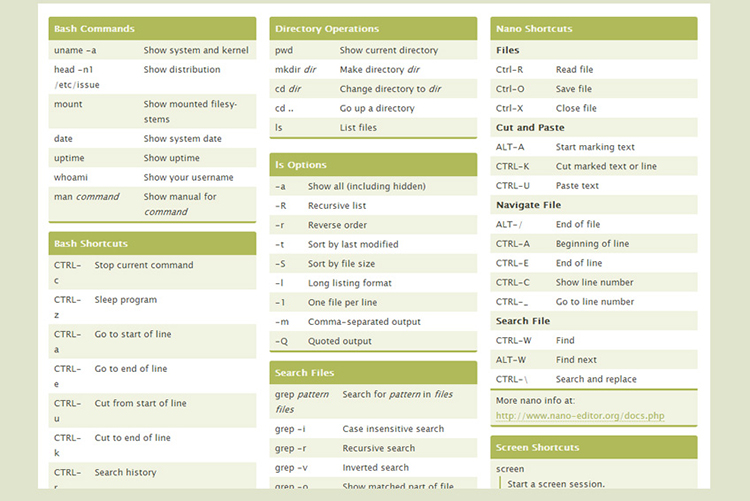
- #Bash commands mac cheat sheet pdf
- #Bash commands mac cheat sheet download
- #Bash commands mac cheat sheet free
Variables functions interpolation brace expansions loops conditional execution command substitution one page guide to bash scripting.
#Bash commands mac cheat sheet pdf
Why is this page titled linux commands cheat sheet in black white when only the color version is supplied as a pdf and the image shown is the color version. In order to avoid confusion try not to refer to a powershell script as a bash script. Result expr 1 2 result2 expr 2 1 2 result expr 2 5 note the on the symbol with bash an expression is normally enclosed using and can use the following operators in order of precedence.
#Bash commands mac cheat sheet free
$ wget # Downloads the entire English King James Bible from Project Gutenberg (used in Linx) $ curl -O # Downloads the entire English King James Bible from Project Gutenberg (used in Mac)įeel free to reuse any of the contents of this course or this web page.Advanced linux commands cheat sheet from red hat.
#Bash commands mac cheat sheet download
To download the contents of any URL (whether it be a file, HTML page or even a picture), there’s a very useful command on Mac and Linux. $ cat output.txt | wc -l > output.txt # Appends the line count of output.txt to the end of output.txt Downloading Files Overwrites the old contents of output.txt (Careful!) $ cat file.txt | sort | uniq -c | sort -nr > output.txt # stores the unique lines of file.txt, with the most frequent line and its count at the top, in output.txt. $ grep "Hello" file.txt > output.txt # Stores every line containing "Hello" in file.txt in a new file output.txt File Output Redirection can be done using the > or > operators. $ cat file.txt | sort | uniq -c | sort -nr | head -100 | shuf | head -10 # take a random sample of 10 of the top 100 most frequent linesīash can also write to files! This makes a life a lot easier than dragging your cursor, copying large chunks of text from the terminal window. $ cat file.txt | grep "phrase" | wc -l # how many lines in this file contain the phrase "phrase" $ cat file.txt | sort | uniq -c | sort -nr # print out the unique lines in file.txt, with the most frequent line and its count at the top $ cat file.txt | sort | uniq | wc -l # how many unique lines are in this file We use the | character to “pipe” one command’s output into another. $ shuf file.txt # shuffle the lines in file.txt Gettin’ fancyīash commands are connecting via “pipes”, which means the input of one command is the output of the previous command. $ grep -v "phrase" file.txt # print out lines in file.txt that don't contain the string "phrase"

$ grep -i "phrase" file.txt # same as above, but ignoring case $ grep "phrase" file.txt # print out lines in file.txt that contain the string "phrase" $ cut -f 1 -d ',' file.csv # print the first column of file.csv, split on comma instead of tab $ cut -f 1 file.txt # print the first column of the file.txt (assumes columns are tab-separated) $ uniq -c file.txt # print out unique lines and the number of times each one occurs $ uniq file.txt # remove duplicate lines (only works if you use "sort" first) $ sort -nr file.txt # sort the lines in file.txt numerically and in reverse order $ sort -r file.txt # sort the lines in file.txt in reverse order $ tar -czvf files/ #create a tar archived file containing the contents of the directory files/ Exploring and reorganizing file contents $ sort file.txt # sort the lines in file.txt (by default, alphabetically and ascending) $ cat file.txt #print the entire contents of file.txt $ tail -NUM file.txt #print the last NUM lines of file.txt (e.g.

$ head -NUM file.txt #print the first NUM lines of file.txt (e.g. $ head file.txt #print the first 10 lines of file.txt $ file file.txt #print the type of the file (e.g. $ wc -l file.txt #print the number of lines in file.txt What the are these files? $ ls -lah file.txt #print the size of file.txt in bytes (also the date it was created) $ rm -r directory # remove directory and all the files within it (again, gone for good). $ rm file.txt # remove file.txt (be careful, it will be gone for good). $ mkdir new_directory # create a new diretory called new_directory ("make directory") $ cd ~/ # take me home ("change directories to the user's home directory") $ cd some/directory # go to some/directory ("change directory") $ pwd # print the directory where you are currently working ("print working directory") $ ls some/directory # list all the files in some/directory Copied from Ellie Pavlick’s favorite bash commands for basic data processing/exploration Where am I? $ ls # list all the files in this directory


 0 kommentar(er)
0 kommentar(er)
